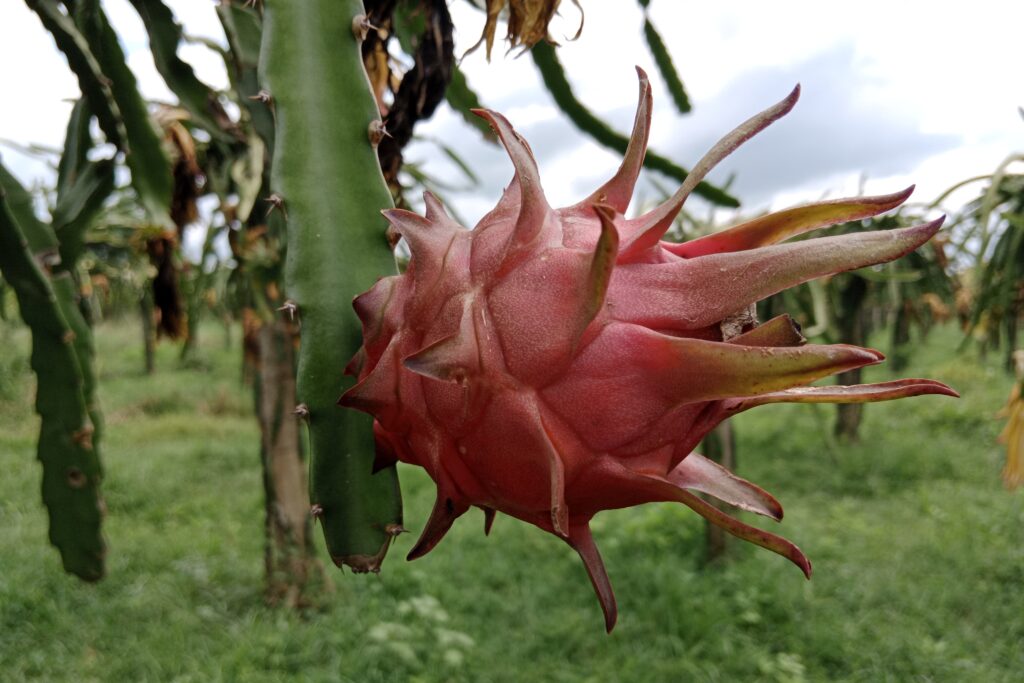Celery Farming
A herbaceous plant known for its therapeutic qualities, celery is frequently used to relieve gout, migraines, anxiety, joint discomfort, promote weight loss, and help purify the blood. Packed with vital minerals like potassium, vitamin C, vitamin K, vitamin B6, and folate, celery is not only good for you but also frequently utilized in cooking dishes like soups, salads, and stews.
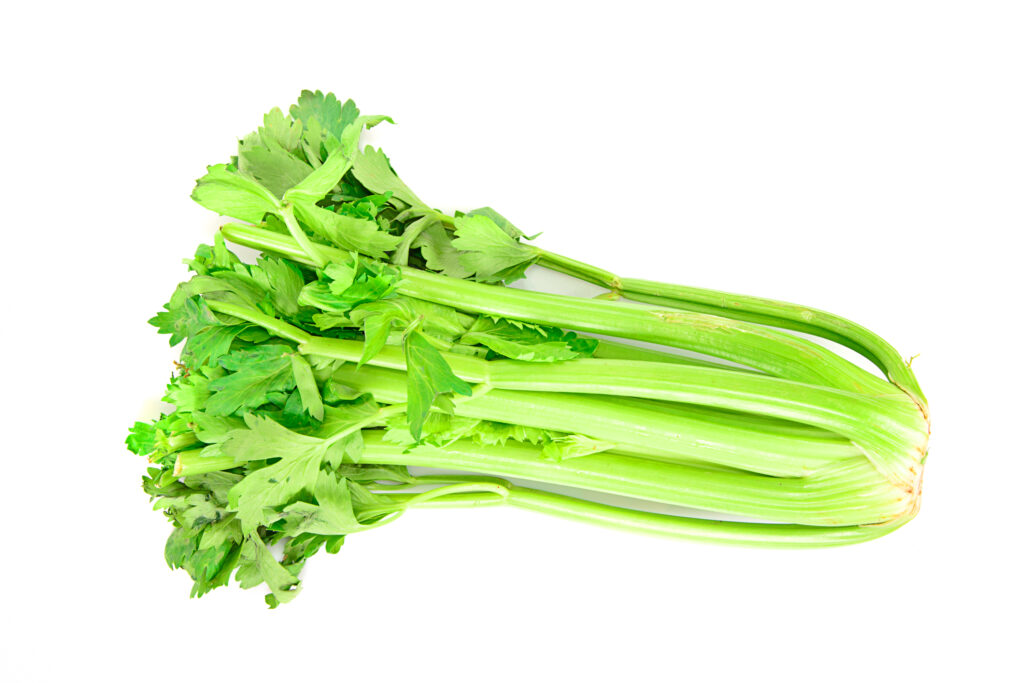
Celery farming profit per acre demonstrates high profitability, with a total investment cost of NRs 50,000 per acre generating total revenue of NRs 200,000. This results in a net profit of NRs 150,000 per acre. Profit margins are strong, showing a 75% profit margin [(150,000/200,000) × 100] and an exceptional 300% Return on Investment (ROI) [(150,000/50,000) × 100]. The cost-to-revenue ratio is 1:4, meaning for every NRs 1 invested, NRs 4 is earned.
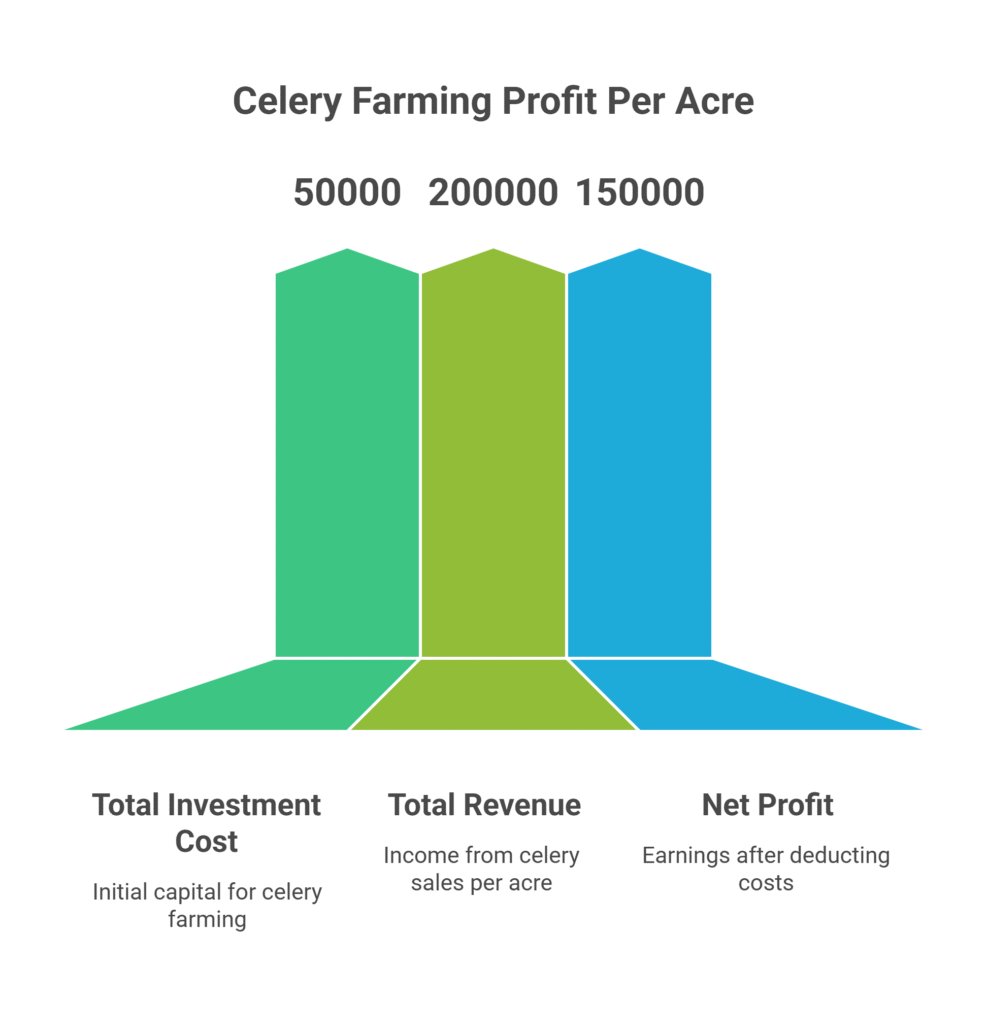
Key insights reveal land preparation (30% of costs) and harvesting (10%) as major cost drivers, while a high yield (10,000 kg/acre) at a stable market price (NRs 20/kg) ensures robust revenue. However, this profit assumes optimal conditions; fluctuations in yield, pests, or prices could impact margins. In conclusion, celery farming is highly lucrative per acre under these assumptions, but success depends on efficient cost management and stable market conditions.
Land Preparation
Land preparation for celery cultivation begins with deep plowing (12–15 inches) to loosen the soil, improve aeration, and facilitate root penetration and drainage. This is followed by repeated harrowing to break down large clods and create a smooth, clod-free tilth essential for the tiny seeds and delicate seedlings. All weeds, stones, and crop residues must be thoroughly removed.
Raised beds, typically 4–6 inches high and 3–4 feet wide, are then formed to improve drainage—especially important in heavy soils or waterlogged areas—with furrows between beds aiding irrigation and runoff. During the final harrowing, well-decomposed farmyard manure or compost, along with a portion of basal inorganic fertilizers such as phosphorus and potassium, should be incorporated into the soil.
Soil Type
Deep, fertile, moisture-retaining yet well-drained loamy soils with more than 2.5% organic matter are ideal for celery growth. It is sensitive to both extremely acidic (below pH 5.5) and extremely alkaline soils, and it likes a pH range of 6.0 to 7.0, which is slightly acidic to neutral. Since celery’s shallow roots are quite prone to rot in wet weather, excellent drainage is crucial.
Heavy clay soils are typically inappropriate unless they are greatly enhanced with organic matter and grown on raised beds, while sandy loams may be appropriate with the right irrigation and fertilizer management. In addition to providing slow-release nutrients, a high amount of organic matter improves drainage, soil structure, and water retention.
Climatic Requirements
Lettuce is best suited to cool weather, with ideal growing temperatures between 15°C and 21°C (59°F to 70°F). Seeds germinate most effectively—though slowly—within the 15–20°C (59–68°F) range, while soil temperatures above 25°C (77°F) can drastically reduce germination success.
The crop thrives in conditions featuring mild daytime temperatures and cool nights; however, prolonged exposure to temperatures above 24°C (75°F) often triggers bolting (premature flowering), resulting in bitter taste, tough stems, and stunted growth. While mature plants can tolerate light frost, severe frosts can cause significant damage.
Lettuce favors full sunlight and moderate to high humidity but can endure partial shade in hotter climates. Notably, longer daylight hours paired with cooler temperatures may induce bolting in certain varieties. Throughout the season, consistent and ample moisture is critical, as water stress can significantly reduce both yield and crop quality.
Major Cultivars
| Cultivar Type | Key Characteristics | Blanching Requirement | Examples |
| Green/Pascal Types | Most common. Dark green stalks, robust flavor, generally more fibrous. | Usually required | Tall Utah 52-70, Conquistador, Command |
| Golden/Self-Blanching Types | Lighter green to yellowish stalks, naturally milder flavor, less fibrous. Often bred for easier blanching. | Reduced or self-blanching | Golden Self-Blanching, Tango |
| Red/Pink Types | Less common. Striking red or pink stalks (especially inner stalks). Color intensifies in cooler weather. | Varies (Similar to Green) | Chinese Pink, Red Venture |
| Stringless Varieties | Modern hybrids bred for significantly reduced fiber/strings, enhancing tenderness. | Varies | Ventura, Conquistador (some types) |
| Bolting Resistant | Essential for spring plantings or regions with fluctuating temperatures to prevent premature flowering. | Varies | Tall Utah 52-70 R Improved, Laguna |
| Specialty Seed/Oil Types | Bred primarily for high-quality seed & oil production. Brown seeds, flowers in March, mature to 140-150 days post-transplant. High oil content (20.1). Yield: 4.46 qtl/acre seed. | N/A (Seed production focus) | Punjab Celery 1 (PAU) |
Seed Rate per Acre
For celery cultivation, the typical seed rate per acre is 100–150 grams when raising seedlings in nursery beds or trays for later transplanting, with higher quantities used if germination rates are expected to be low. In contrast, direct seeding—though rarely practiced commercially due to its challenges—requires a significantly higher rate of about 400 grams per acre to compensate for lower field germination and the need for thinning.
Nursery Management
Before sowing celery seeds, apply a mixture of calcium ammonium nitrate and single superphosphate at the rate of 150 grams per raised bed. Prepare raised beds of around 8 meters in length and 1.25 meters in width, or as per convenience. After sowing, cover the beds with well-decomposed farmyard manure (FYM) and mix it thoroughly into the soil. It’s important to irrigate the beds immediately using a water sprinkler to ensure proper moisture for seed germination.
Germination usually begins 12 to 15 days after sowing. Once seedlings start emerging, calcium ammonium nitrate should be applied to each bed every fortnight. To promote healthy plant growth and achieve good plant size, apply 100 grams of calcium ammonium nitrate per bed every month. Seedlings become ready for transplanting 60 to 70 days after sowing. Before transplanting, give light irrigation to make uprooting easier and maintain seedling turgidity. Transplanting is typically carried out between mid-November and the end of December.
Planting
a). Planting Season
Celery, being a Rabi crop, requires nursery preparation during September- October.
b). Spacing
Celery should be planted with a row-to-row spacing of 45 cm and a plant-to-plant spacing of 20 cm within the row. Larger varieties or those grown using the trenching method may require slightly wider spacing to accommodate their growth.
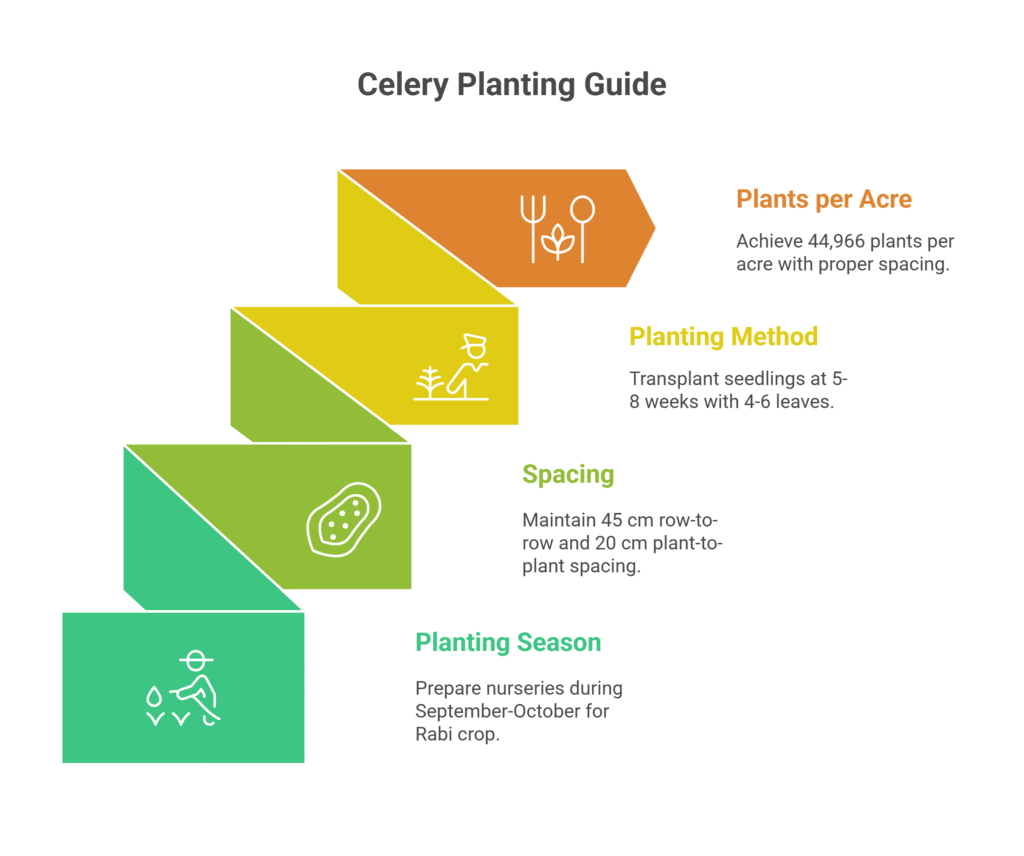
c). Planting Method
Celery seedlings become suitable for transplanting at 5 to 8 weeks of age, once they have developed four to six true leaves. Before moving them outdoors, it’s important to harden them off to help them adjust to external conditions. During transplanting, place the seedlings at a depth of 2–4 cm, lightly firm the soil around the roots, and water immediately to ensure successful establishment.
Direct seeding involves sowing celery seeds thinly in shallow furrows on well-prepared beds, followed by careful thinning to ensure proper plant spacing. However, this method is not recommended for commercial cultivation due to its labor-intensive nature and lower success rates compared to transplanting.
d). Number of Plants per Acre
An acre can support about 44,966 celery plants if rows are spaced 45 cm apart and plants are 20 cm apart inside a row.
Intercropping
Celery can be intercropped with fast-growing, upright crops that do not heavily compete for light or nutrients, such as onions, leeks (which may also help deter pests), cabbage, cauliflower (in early stages), and bush-type beans. However, it is advisable to avoid intercropping with heavy feeders like corn or squash and tall crops that can shade celery. Proper spacing, along with careful management of irrigation and fertilization, is essential for the success of intercropping. While beneficial in small-scale or mixed farming systems, intercropping is less commonly practiced in large-scale commercial celery cultivation.
Irrigation
Consistent and abundant moisture is crucial for celery, as the crop consists of approximately 95% water and has a shallow root system. Drip irrigation is ideal, offering efficient water use, reduced disease risk by keeping foliage dry, and precise nutrient delivery through fertigation. In areas where drip systems are unavailable, furrow irrigation is commonly used. Moisture stress can severely impact plant health, leading to stunted growth, tough and stringy stalks with a bitter taste, and increased vulnerability to pests and diseases.
Fertilizer and Manure
Soil testing is essential for providing accurate and tailored fertilizer recommendations, as celery is a heavy feeder with high nutrient demands, especially for nitrogen (N) and potassium (K), which are critical for optimal growth and yield.
| Fertilizer Type | Material | Rate per Acre | Application Timing/Method | Purpose/Notes |
| Organic Matter | Well-rotted FYM or compost | 15-20 tons | Incorporated before planting | Improves soil structure and nutrient base |
| Nitrogen (N) | Inorganic fertilizer | 50 kg | Split: Basal, 45 DAP, and 75 DAP | Crucial for stalk growth |
| Phosphorus (P₂O₅) | Inorganic fertilizer | 30 kg | Mostly basal application | Standard phosphorus supplementation |
| Potassium (K₂O) | Inorganic fertilizer | 30 kg | Split: Basal + Top dressing | Vital for stalk quality, firmness, and disease resistance |
| Boron (B) | Borax or soluble boron | 2 kg | As needed (based on deficiency symptoms) | Prevents cracked stem and brown checking (common deficiency in celery) |
Weed Control
Weed control is crucial in celery cultivation, as weeds compete aggressively for water, nutrients, and sunlight, which can significantly reduce yields. Mechanical methods such as shallow hoeing or hand weeding are effective, particularly during the early growth stages, but must be done carefully to avoid damaging the crop’s shallow roots. Mulching with organic materials like straw or compost, or using plastic mulch, is also effective in suppressing weed growth, conserving soil moisture, and regulating temperature, with plastic mulch being a common practice in commercial production.
Flowering and Fruit Management
Premature flowering, or bolting, is a major issue in celery cultivation, caused by factors such as prolonged exposure to cold temperatures below 10°C (50°F) during early growth (vernalization), long day lengths during warmer periods, and stress from heat or inadequate moisture.
To manage bolting, it is recommended to grow bolt-resistant cultivars, especially for spring planting, avoid early sowing of non-resistant varieties, and ensure consistent growth through proper irrigation and nutrient management. Harvesting should be done promptly once the crop reaches maturity, as bolting leads to tough, hollow, and bitter stalks, rendering the celery unmarketable. Notably, celery is cultivated for its stalks and leaves, not its fruit.
Pest and Disease Management
Common Pests
a). Aphids
Common celery pests like aphids, which feed on plant sap and can spread viruses, cause stunted development and decreased output. Examples of these pests are the Green Peach and Foxglove types. Neem-based sprays, insecticidal soaps or horticultural oils, and powerful water sprays to remove them are all effective control techniques. It is also advantageous to use biological control with natural predators such as lacewings and ladybugs. Selective insecticides, like acetamiprid (1 milliliter per liter of water), can be used for severe infestations.
b). Leafminers
Leafminers are pests whose larvae tunnel through celery leaves, giving them a scorched appearance and reducing the plant’s photosynthetic capacity. Effective control includes promptly removing and destroying infested leaves, encouraging natural predators like parasitic wasps, and applying insecticides such as spinosad or abamectin. Insecticidal sprays are commonly used to manage severe infestations and protect healthy foliage.
c). Whiteflies
Whiteflies are sap-sucking pests that excrete honeydew, leading to the development of sooty mold on celery leaves, which hampers photosynthesis and overall plant health. Control measures include the use of yellow sticky traps to monitor and reduce adult populations, insecticidal soaps or horticultural oils, neem-based treatments, and biological control using parasitic wasps like Encarsia formosa. In severe cases, selective insecticides such as quinalphos at a rate of 2 ml per litre of water can be applied for effective management.
d). Cutworms/Celery Worms (Armyworms)
Cutworms and celery worms (including armyworms) chew on stems and leaves, often damaging young plants. Control methods include using collars around seedlings, hand-picking larvae, and applying Bacillus thuringiensis (Bt) or spinosad. Early detection and timely action are essential for effective management.
Common Diseases
a). Early Blight (Cercospora)
Early blight, also known as Cercospora leaf spot or Cercospora blight, is a fungal disease caused by Cercospora apii, characterized by small yellow spots appearing on both the upper and lower surfaces of celery leaves. To control the infestation, apply a foliar spray of Zineb 75WP or M-45 at the rate of 400 grams per acre, mixed in 150 liters of water, as soon as symptoms are observed.
b). Fusarium Yellows/Wilt
The fungal disease known as Fusarium yellows, which is brought on by Fusarium oxysporum, is typified by vascular tissue discoloration, browning of the roots, and restricted plant growth. Contaminated agricultural equipment is the main way that the disease is transmitted. As soon as symptoms appear, use 400 grams of copper oxychloride or M-45 per acre diluted in 150 liters of water to the afflicted area for efficient control.
c). Downey Mildew
Downy mildew is a fungal disease caused by Peronospora umbellifarum, which presents as yellow spots on the upper side of leaves, white fluffy growth on the underside, and darkening lesions as the plant matures. At the first sign of infestation, apply a treatment of 400 grams of Copper Oxychloride or M-45 per acre, diluted in 150 liters of water, to the affected area.
c). Pink Rot
Pink rot is a disease characterized by water-soaked lesions at the base of the plant that turn pink or brown, and it is favored by waterlogged conditions. Effective control involves improving soil drainage, avoiding overwatering, and applying preventative fungicides such as mefenoxam or phosphites to protect the crop.
d). Bacterial Leaf Spot
Wet weather and splashing water encourage the growth of bacterial leaf spot, which results in angular, water-soaked lesions that develop dark or black. Applying copper-based pesticides, cultivating resistant cultivars, avoiding overhead watering to prevent leaf moisture, and rotating crops to reduce disease accumulation are some control strategies.
Harvesting
Harvest celery when the stalks reach a marketable size—both in height and diameter—and are firm and crisp, typically 85 to 120 days after transplanting, before significant bolting or pithiness occurs. Key indicators include a full-sized head, a tight crown, and crisp petioles that snap easily; plants that are overly mature, pithy, or bolted should be avoided.
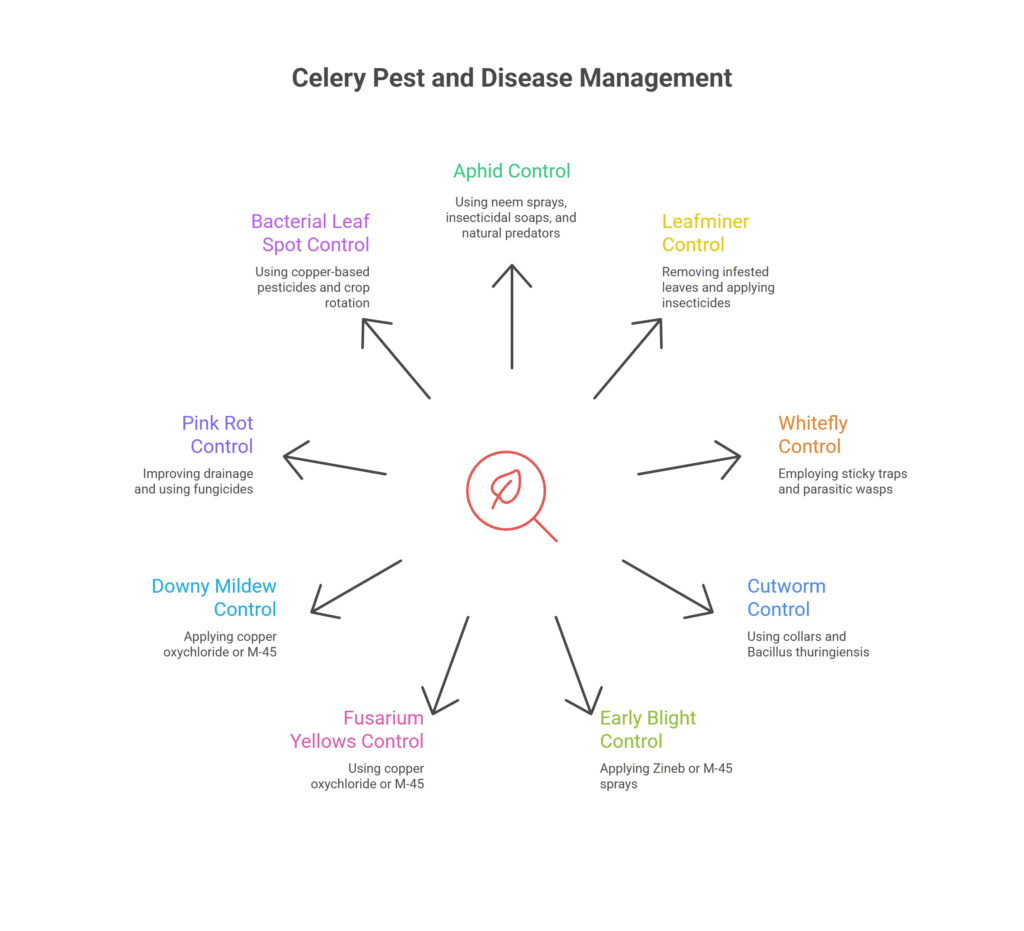
Harvesting is most commonly done by hand, cutting the whole plant just below the soil line with a sharp knife, and trimming outer leaves as needed. In large-scale operations, mechanical harvesters may be used to undercut and lift the plants. Careful handling is essential to prevent bruising, with roots and excess leaves trimmed, and rapid cooling through hydrocooling or forced-air cooling applied immediately after harvest to remove field heat and preserve crispness.
Yield
The average yield of celery is approximately 10 – 12 tons per acre.
Cost of Investment per Acre for Celery Farming
| S.N. | Category | Cost (NRs) |
| 1 | Land Preparation (plowing) | 15,000 |
| 2 | Seed | 1,000 |
| 3 | Nursery management | 5,000 |
| 4 | Transplanting | 3,000 |
| 5 | Fertilizers and Manure | 8,000 |
| 6 | Irrigation | 3,000 |
| 7 | Weed Control (pre & post-emergence) | 2,000 |
| 8 | Pest & Disease Control | 3,000 |
| 9 | Harvesting | 5,000 |
| 10 | Miscellaneous Costs | 5,000 |
| Total Cost | 50,000 |
Income from per acre celery farming
| Particulars | Yield (kg/acre) | Price (NRs/kg) | Income (NRs) |
| Fresh Leaves Yield | 10,000 | 20 | 200,000 |
Analysis of Celery farming profit per acre
With a total investment cost of NRs 50,000 and total revenue of NRs 200,000, celery farming exhibits high profitability, yielding a net profit of NRs 150,000. This corresponds to an impressive return on investment (ROI) of 300%, a profit margin of 75%, and a cost-to-revenue ratio of 1:4, meaning that for every NRs 1 invested, NRs 4 is made.
While a consistent market price (NRs 20/kg) and a high yield (10,000 kg/acre) drive revenue, land preparation accounts for 30% of expenditures and harvests for 10%. Profitability, however, depends on reaching the best yield and market pricing because pest or other factor variations can have a big impact on margins. All things considered, when well run and aided by advantageous market circumstances, celery farming can yield extremely high profits per acre.
Crop Calendar for Celery Farming
| Month | Growth Stage | Key Activities | Duration/Timing |
| September | Nursery Preparation | · Prepare raised nursery beds (8m × 1.25m). · Apply basal mix: 150g CAN + SSP per bed. · Sow seeds (100–150g/acre). · Cover with FYM; irrigate with sprinkler. | Early–Mid September |
| October | Nursery Management | · Monitor germination (starts 12–15 days post-sowing). · Fortnightly CAN application (100g/bed). · Maintain moisture; harden seedlings. | Throughout October |
| November | Transplanting | · Transplant seedlings (5–8 weeks old, 4–6 true leaves). · Spacing: 45 cm × 20 cm (44,966 plants/acre). · Apply basal fertilizers (FYM + NPK). · Irrigate immediately. | Mid-November to end December (Avoid early sowing for bolt-sensitive cultivars) |
| December | Early Growth | · Ensure consistent irrigation (drip/furrow). · Weed control (shallow hoeing/mulching). · Monitor pests (aphids, leafminers). | Weeks 1–4 post-transplant |
| January | Vegetative Growth | · Apply 1st top-dressing (N+K at 45 DAP). · Check boron deficiency; apply borax if needed. · Pest/disease scouting (whiteflies, early blight). | Weeks 5–8 post-transplant |
| February | Bulking Stage | · Apply 2nd top-dressing (N+K at 75 DAP). · Maintain soil moisture; avoid water stress. · Control diseases (downy mildew, pink rot). | Weeks 9–12 post-transplant |
| March | Pre-Harvest | · Stop irrigation 3–5 days before harvest. · Monitor for bolting; harvest if flowering initiates. · Final pest check. | Weeks 13–16 post-transplant |
| April | Harvest | · Harvest when stalks are firm/crisp (height: 12–18″). · Cut at soil line; trim outer leaves. · Hydrocool immediately; pack for market. | 85–120 days post-transplant (Mid-February |
Sources
Food and Agriculture Organization (FAO)
University of California Agriculture & Natural Resources (UC ANR)
Punjab Agricultural University (PAU)
Tamil Nadu Agriculture University (TNAU) – Agritech portal
Indian Council of Agricultural Research (ICAR)
Nepal Agricultural Research Council (NARC)

